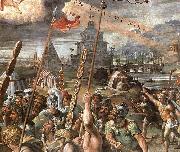
|
RAFFAELLO Sanzio
|
|||
|
|
|||
| Italian High Renaissance Painter, 1483-1520 Italian painter and architect. As a member of Perugino's workshop, he established his mastery by 17 and began receiving important commissions. In 1504 he moved to Florence, where he executed many of his famous Madonnas; his unity of composition and suppression of inessentials is evident in The Madonna of the Goldfinch (c. 1506). Though influenced by Leonardo da Vinci's chiaroscuro and sfumato, his figure types were his own creation, with round, gentle faces that reveal human sentiments raised to a sublime serenity. In 1508 he was summoned to Rome to decorate a suite of papal chambers in the Vatican. The frescoes in the Stanza della Segnatura are probably his greatest work; the most famous, The School of Athens (1510 C 11), is a complex and magnificently ordered allegory of secular knowledge showing Greek philosophers in an architectural setting. The Madonnas he painted in Rome show him turning away from his earlier work's serenity to emphasize movement and grandeur, partly under Michelangelo's High Renaissance influence. The Sistine Madonna (1513) shows the richness of colour and new boldness of compositional invention typical of his Roman period. He became the most important portraitist in Rome, designed 10 large tapestries to hang in the Sistine Chapel, designed a church and a chapel, assumed the direction of work on St. Peter's Basilica at the death of Donato Bramante, | |||
|
|
|||
|
Vision of the Cross new18/RAFFAELLO Sanzio-689872.jpg Painting ID:: 51249 |
1520-24 Fresco Stanza di Constantino | ||
|
|
|||
|
RAFFAELLO Sanzio
|
|||
|
|
|||
| Italian High Renaissance Painter, 1483-1520 Italian painter and architect. As a member of Perugino's workshop, he established his mastery by 17 and began receiving important commissions. In 1504 he moved to Florence, where he executed many of his famous Madonnas; his unity of composition and suppression of inessentials is evident in The Madonna of the Goldfinch (c. 1506). Though influenced by Leonardo da Vinci's chiaroscuro and sfumato, his figure types were his own creation, with round, gentle faces that reveal human sentiments raised to a sublime serenity. In 1508 he was summoned to Rome to decorate a suite of papal chambers in the Vatican. The frescoes in the Stanza della Segnatura are probably his greatest work; the most famous, The School of Athens (1510 C 11), is a complex and magnificently ordered allegory of secular knowledge showing Greek philosophers in an architectural setting. The Madonnas he painted in Rome show him turning away from his earlier work's serenity to emphasize movement and grandeur, partly under Michelangelo's High Renaissance influence. The Sistine Madonna (1513) shows the richness of colour and new boldness of compositional invention typical of his Roman period. He became the most important portraitist in Rome, designed 10 large tapestries to hang in the Sistine Chapel, designed a church and a chapel, assumed the direction of work on St. Peter's Basilica at the death of Donato Bramante, | |||
|
|
|||
|
Vision of the Cross new21/RAFFAELLO Sanzio-862864.jpg Painting ID:: 63807 |
1520-24 Fresco Stanza di Constantino, Palazzi Pontifici, Vatican The view of the "Tomb-pyramid of Romulus", which is no longer there, and the so-called Citadel of Sant'Angelo together with the bridge of Sant'Angelo, is an example of Raphael's interest in ancient Rome. The view Raphael has chosen more or less matches the view he had of Rome in 1520 from his Vatican loggie, which are located right behind the wall painted with the fresco. The Citadel of Sant'Angelo appears to be Raphael's reconstruction of the original ancient building, the erstwhile Hadrian Mausoleum, as it might have looked in the days of Emperor Constantine. By depicting this view of ancient Rome, Raphael is suggesting to anyone viewing that fresco that Constantine experienced his vision in the precise place where the Vatican State is now located. By this means Raphael was able to confirm in a very subtle manner, that the Popes had established themselves in Rome - more specifically - in the Vatican.Artist:RAFFAELLO Sanzio Title: Vision of the Cross (detail) Painted in 1501-1550 , Italian - - painting : historical | ||
|
|
|||
|
Also Buy::. For Following Paintings / Artists / Products, Please Use Our Search Online: |









